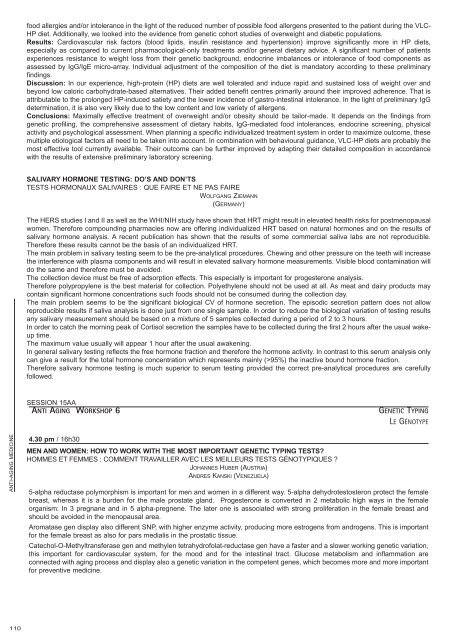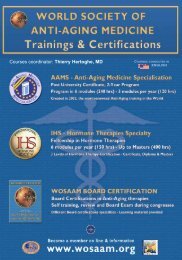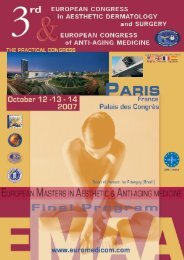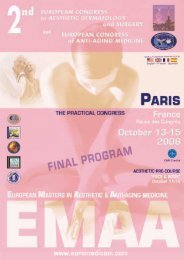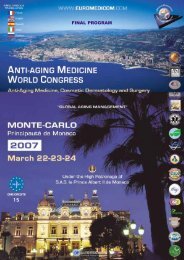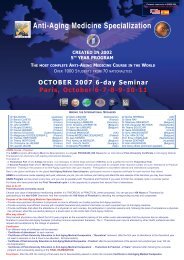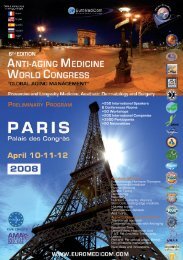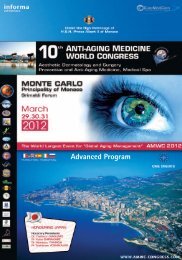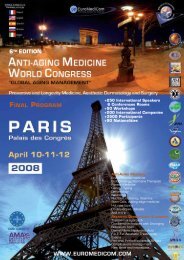performance.Outcome studies of anti-obesity drugs indicate a lack of efficacy in achieving weight loss. Population studies indicate that geneticvariance in genes encoding cellular metabolism and uncoupling proteins might attenuate energy homeostasis. Other population-basedreports stress the importance of behavioural therapy in the treatment of overweight patients.Conclusions: We conclude that obesity is a pathophysiological sign of a gene/behaviour/environment mismatch. For the effectivetreatment of the individual obese patient, all of the confounding variables (genetic layout, environment and psychological profile)should be assessed according to the current standards.NATURE'S ANSWER TO SEXUAL HYPOFUNCTION: THE HORMONOMIMETIC AND ANTIOXIDANT PROPERTIES OFICARIIN IN RELATION WITH MALE AND FEMALE SEXUAL WELLBEINGLA RÉPONSE DE LA NATURE À L'HYPOFONCTIONNEMENT SEXUEL : L'HORMONOMIMÉTISME ET LES PROPRIÉTÉSANTIOXYDANTES DE L'ICARIINE ASSOCIÉS AU BIEN-ÊTRE SEXUEL MASCULIN ET FÉMININROCK R. GOERDIN(BELGIUM)Background: Icariin, a flavonol glycoside found in Herba Epimedii is purported to enhance sexual wellbeing in both males and females.Epimedium is a Chinese herb used in traditional medicine to treat fatigue, arthritic and nerve pain, and sexual dysfunction. Use ofEpimedium is thought to attenuate levels and actions of several sex hormones.Several animal experiments suggest an attenuation of sexual desire and erectile function by epimedium extracts. Furthermore, these arereflected in the anecdotal positive effects on sexual experience of patients with over the counter (OTC) preparations containing Icariin.Purpose: To further clarify the actions of Epimedium extract on erectile dysfunction and attenuation of tumescence and sexual desirein both males and females.To highlight, in particular, the clinical potential of Icariin - as a standardized Epimedium component- in the treatment of age-relatedsexual hypofunction.Methods: The authors searched the scientific literature for documentation and clarification of the subject.Results:In vitro studies: In in-vitro studies of smooth muscle cells lining the corpus cavernosum of the penis, icariin blocks the degradativeaction of PDE5 on cGMP. Results of in vitro studies suggest that components of Epimedium, especially icariin, exhibit neuroprotective,immunomodulatory and anticancer effects. Epimedium grandiflorum was reported to have anti-HIV activity in vitro.Animal models: Animal studies confirm these findings and suggest attenuation of sexual desire and increased tumescence in severalanimal models.Icariin also stimulates the differentiation of osteoblasts and increases the activity of alkaline phosphatase (ALP) and the expression ofI-collagen protein in Sprague-Dawley rats, hereby promoting bone formation. Serum testosterone concentration is also significantlyelevated compared with the control group.Icariin improved the condition of reproductive organs and increases the circulating levels of testosterone. In animal models, it increasesthe sexual desire in both males and females. Therefore, Icariin may be of benefit in the management of partial androgen deficiency inthe aging male.Human trials: The findings in relation with osteoporosis were replicated in a randomized placebo-controlled trial, where Icariinprevented bone loss in postmenopausal women. Icariin treatment improved the steady-state serum osteocalcin. This indicatesosteogenesis by increased oseoblastic activity.Discussion: Icariin is a new kind of biological modifier and differential agent with possible anticancer effects. It also acts as aprotective agent for postmenopausal osteoporosis.Icariin acts as a cyclic Guanosine Mono Phosphate (cGMP)-specific Phosphodiesterase (PDE5) type 5 inhibitor. This facilitates therelease of nitric oxide (NO), which is part of the physiological process resulting in penile erection and clitoral tumescence as a resultof sexual stimulation. This attributes to Icariin a clear-cut potential for treating erectile dysfunction(ED).The testosterone mimetic properties may also be beneficial in females to enhance both sexual tumescence and desire.Conclusions: Icariin carries significant testosterone mimetic properties. No major side effects have been reported.These findings make epimedium herb extracts a potential candidate for use in the treatment of age-related sexual dysfunction,particularly when attributable to hormonal deficits.In females, it is potentially beneficial as a sexual enforcer, boosting desire and wellbeing. In males, it can increase sexual desire anderectile function in an explicit way.On the scientific and anecdotal basis currently available, Icariin can be safely recommended as the best documented substance forincreased sexual wellbeing that occurs in nature.More randomized prospective trials, in particular with standardized compositions, are required both to quantify the dose-effectrelationship in the enhancement of sexual function as well as to define the possible subgroups for specific indications.ANTI-AGING MEDICINETHE ADDED VALUE OF EXTENSIVE PRELIMINARY LABORATORY SCREENING TO VERY LOW CALORIC DIETSWITH HIGH PROTEIN CONTENTLA VALEUR AJOUTÉE DES LARGES EXAMENS DE LABORATOIRE PRÉLIMINAIRES DANS LES RÉGIMES BASSESCALORIES HYPERPROTÉINÉSFRANCINE TEMPELS(BELGIUM)Background: To date, the worldwide ratio of overweight to underweight individuals has reached unity. This number remains steadilyon the increase. Several pharmacological interventions and dietary approaches have been proven to be largely ineffective, both interms of sustained weight loss as well as improvement of cardiovascular risk factors. Due to the multifactorial etiology of obesity, clearcut management has remained elusive.To date, the use of very low caloric diets with high protein content (VLC-HP) in the treatment of obesity has proven to be both safeand effective. Considerable improvement in biomarkers of cardiovascular risk and insulin resistance is seen in the majority of patientsthat are compliant with the dietary plan.Materials and Methods: We reviewed the current literature on pharmacological and dietary treatments of overweight and obesity andthe impact on the individual changes in cardiovascular and metabolic risk factors. We included studies that addressed the influence of109
food allergies and/or intolerance in the light of the reduced number of possible food allergens presented to the patient during the VLC-HP diet. Additionally, we looked into the evidence from genetic cohort studies of overweight and diabetic populations.Results: Cardiovascular risk factors (blood lipids, insulin resistance and hypertension) improve significantly more in HP diets,especially as compared to current pharmacological-only treatments and/or general dietary advice. A significant number of patientsexperiences resistance to weight loss from their genetic background, endocrine imbalances or intolerance of food components asassessed by IgG/IgE micro-array. Individual adjustment of the composition of the diet is mandatory according to these preliminaryfindings.Discussion: In our experience, high-protein (HP) diets are well tolerated and induce rapid and sustained loss of weight over andbeyond low caloric carbohydrate-based alternatives. Their added benefit centres primarily around their improved adherence. That isattributable to the prolonged HP-induced satiety and the lower incidence of gastro-intestinal intolerance. In the light of preliminary IgGdetermination, it is also very likely due to the low content and low variety of allergens.Conclusions: Maximally effective treatment of overweight and/or obesity should be tailor-made. It depends on the findings fromgenetic profiling, the comprehensive assessment of dietary habits, IgG-mediated food intolerances, endocrine screening, physicalactivity and psychological assessment. When planning a specific individualized treatment system in order to maximize outcome, thesemultiple etiological factors all need to be taken into account. In combination with behavioural guidance, VLC-HP diets are probably themost effective tool currently available. Their outcome can be further improved by adapting their detailed composition in accordancewith the results of extensive preliminary laboratory screening.SALIVARY HORMONE TESTING: DO’S AND DON’TSTESTS HORMONAUX SALIVAIRES : QUE FAIRE ET NE PAS FAIREWOLFGANG ZIEMANN(GERMANY)The HERS studies I and II as well as the WHI/NIH study have shown that HRT might result in elevated health risks for postmenopausalwomen. Therefore compounding pharmacies now are offering individualized HRT based on natural hormones and on the results ofsalivary hormone analysis. A recent publication has shown that the results of some commercial saliva labs are not reproducible.Therefore these results cannot be the basis of an individualized HRT.The main problem in salivary testing seem to be the pre-analytical procedures. Chewing and other pressure on the teeth will increasethe interference with plasma components and will result in elevated salivary hormone measurements. Visible blood contamination willdo the same and therefore must be avoided.The collection device must be free of adsorption effects. This especially is important for progesterone analysis.Therefore polypropylene is the best material for collection. Polyethylene should not be used at all. As meat and dairy products maycontain significant hormone concentrations such foods should not be consumed during the collection day.The main problem seems to be the significant biological CV of hormone secretion. The episodic secretion pattern does not allowreproducible results if saliva analysis is done just from one single sample. In order to reduce the biological variation of testing resultsany salivary measurement should be based on a mixture of 5 samples collected during a period of 2 to 3 hours.In order to catch the morning peak of Cortisol secretion the samples have to be collected during the first 2 hours after the usual wakeuptime.The maximum value usually will appear 1 hour after the usual awakening.In general salivary testing reflects the free hormone fraction and therefore the hormone activity. In contrast to this serum analysis onlycan give a result for the total hormone concentration which represents mainly (>95%) the inactive bound hormone fraction.Therefore salivary hormone testing is much superior to serum testing provided the correct pre-analytical procedures are carefullyfollowed.SESSION 15AAANTI AGING WORKSHOP 6 GENETIC TYPINGLE GÉNOTYPEANTI-AGING MEDICINE4.30 pm / 16h30MEN AND WOMEN: HOW TO WORK WITH THE MOST IMPORTANT GENETIC TYPING TESTS?HOMMES ET FEMMES : COMMENT TRAVAILLER AVEC LES MEILLEURS TESTS GÉNOTYPIQUES ?JOHANNES HUBER (AUSTRIA)ANDRES KANSKI (VENEZUELA)5-alpha reductase polymorphism is important for men and women in a different way. 5-alpha dehydrotestosteron protect the femalebreast, whereas it is a burden for the male prostate gland. Progesterone is converted in 2 metabolic high ways in the femaleorganism: In 3 pregnane and in 5 alpha-pregnene. The later one is associated with strong proliferation in the female breast andshould be avoided in the menopausal area.Aromatase gen display also different SNP, with higher enzyme activity, producing more estrogens from androgens. This is importantfor the female breast as also for pars medialis in the prostatic tissue.Catechol-O-Methyltransferase gen and methylen tetrahydrofolat-reductase gen have a faster and a slower working genetic variation,this important for cardiovascular system, for the mood and for the intestinal tract. Glucose metabolism and inflammation areconnected with aging process and display also a genetic variation in the competent genes, which becomes more and more importantfor preventive medicine.110


